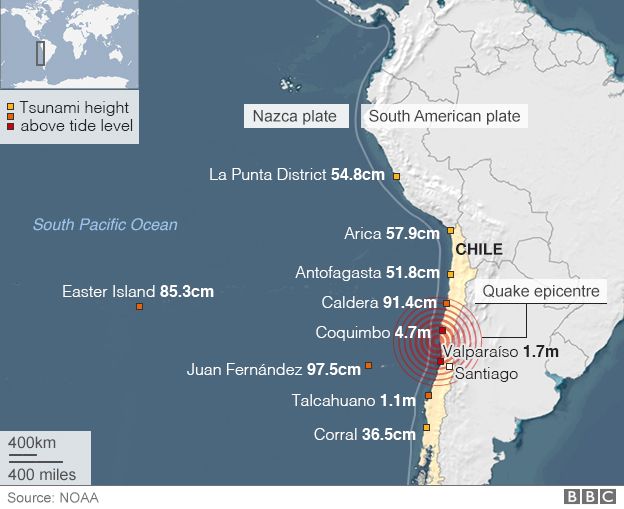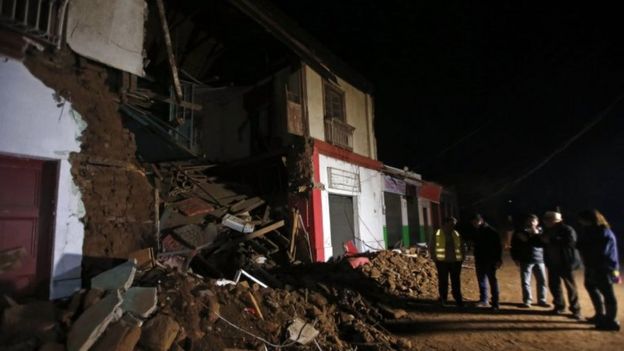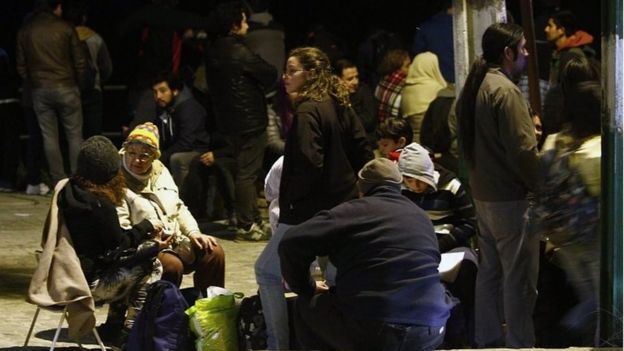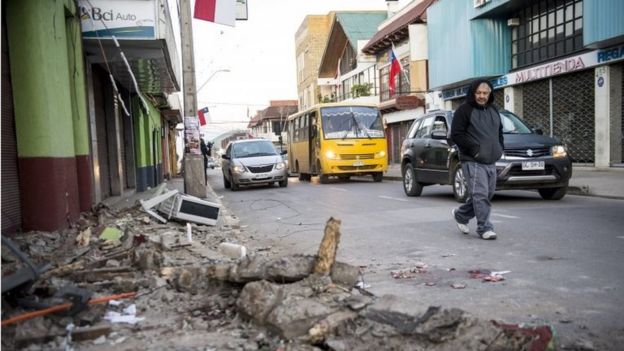One million people had to leave their homes in Chile after a powerful quake hit the country's central region.
At least eight people died when the 8.3-magnitude quake hit. One person is still missing.
Residents of Illapel, near the quake's epicentre, fled into the streets in terror as their homes began to sway.
In the coastal town of Coquimbo, waves of 4.7m (15ft) hit the shore. A tsunami alert was issued for the entire Chilean coast but has since been lifted.
Tsunami waves also hit the coast further north and south of the quake's epicentre, with waves half a metre higher than usual as far north as La Punta.

The quake lasted for more than three minutes and there have been dozens of aftershocks.
Gloria Navarro, who lives in the coastal town of La Serena, said people were "running in all directions".
At the scene: Jane Chambers, freelance journalist
I'm on the coast about 130km (80 miles) south from the worst affected area of Coquimbo. Our house is on top of a cliff and made of wood. It was shaking and shuddering.
At first I thought it was just a tremor but it was really strong and went on for around three minutes. It was much stronger than any tremors I had ever felt before.
The house is fine as most of Chile's buildings are built to withstand tremors.
The local town was evacuated. The restaurant down on the beach is flooded but most things here are returning to normal.
Officials said 1,800 people in Illapel were left without drinking water.
Electricity providers said hundreds of thousands of their clients in the worst-affected Coquimbo region had no power.
 AFP
AFP AP
AP Reuters
Reuters
The US Geological Survey (USGS) said the tremor struck off the coast of Coquimbo, 46km (29 miles) west of the city of Illapel at 19:54 local time (22:54 GMT).
The USGS said it was at a depth of 25km, while Chilean seismologists calculated its depth at 11km.
Analysis: Jonathan Amos, BBC Science Correspondent
 Reuters
Reuters
The quake that rocked Chile on Wednesday was five times more energetic than the one that devastated Nepal back in April. And yet the early indications are that the death toll will be a fraction (perhaps a thousandth) of what it was in the Himalayan nation.
In large part, this is simply down to preparedness. This was Chile's third massive quake in five years; the region all too frequently experiences magnitude 8 events. As a consequence, the building codes are strict and generally well enforced.
What is more, the people themselves are well versed in how to react during and after an event.
It is not perfect. In 2010, an 8.8-magnitude quake witnessed failings on the part of the monitoring network and the system for alerting people to the imminent tsunami threat.
Since then, the Chilean government has spent millions upgrading the country's seismic network of sensors, and made improvements to telecommunications systems that share critical information and warnings.
The earthquake struck as thousands of Chileans were travelling to the coast ahead of a week of celebrations for independence day.
President Michelle Bachelet said some of the official festivities would be cancelled.
The authorities were quick to issue tsunami alerts keen to avert a repeat of the slow response to the 8.8-magnitude quake in 2010, which devastated large areas of the country.
More than 500 people died in that quake and the tsunami it triggered and memories of the tragedy are still raw.
 AFP
AFP AFP
AFP AFP
AFP
Tsunami alerts were issued shortly after the quake struck for the entire Chilean coast but have been gradually lifted, with the last cancelled at 06:22 local time.
President Bachelet said that "once again we must confront a powerful blow from nature". She will travel to the affected areas later on Thursday.
Chile is one of the most seismically active locations on the globe.
It runs along the boundary between the Nazca and South American tectonic plates. These are vast slabs of the Earth's surface that grind past each other at a rate of up to 80mm per year.
No comments:
Post a Comment